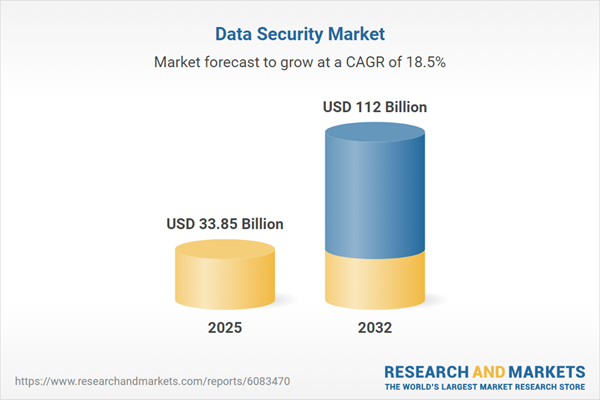Speak directly to the analyst to clarify any post sales queries you may have.
The data security market is undergoing rapid transformation as global enterprises adapt to increasingly sophisticated cyber threats and evolving regulatory mandates. Decision-makers are seeking integrated, future-ready solutions to ensure robust protection across diverse environments and stay ahead of compliance requirements.
Market Snapshot: Data Security Market Size and Growth
The data security market grew from USD 28.85 billion in 2024 to USD 33.85 billion in 2025, illustrating significant year-over-year expansion. With an expected CAGR of 18.47%, the market is projected to reach USD 112.00 billion by 2032. This momentum is propelled by the proliferation of digital transformation, heightened awareness of cyber risks, and regulatory actions worldwide, reshaping organizational priorities and technology investment patterns.
Scope & Segmentation
The scope of this research covers a comprehensive range of components, deployment models, organization sizes, industries, and regional markets. The analysis enables executives to pinpoint targeted opportunities and benchmark strategies effectively.
- Component Types: Services (managed and professional, including consulting, support, maintenance, training, education), Solutions (data encryption, masking, resiliency, identity and access management).
- Deployment Modes: Cloud-based, hybrid, and on-premises architectures are profiled to reflect preferences for agility, control, and regulatory compliance.
- Organization Sizes: Large enterprises and small & medium enterprises, with a focus on unique demands, resource allocations, and risk profiles.
- Industry Verticals: Banking and financial services, insurance, energy and utilities, government and defense, healthcare, IT and telecommunications, manufacturing, retail, and eCommerce. Each sector’s strategic priorities and regulatory needs are examined.
- Regional Coverage: Americas (United States, Canada, Mexico, Brazil, Argentina, Chile, Colombia, Peru), EMEA (UK, Germany, France, Russia, Italy, Spain, Netherlands, Sweden, Poland, Switzerland, UAE, Saudi Arabia, Qatar, Turkey, Israel, South Africa, Nigeria, Egypt, Kenya), Asia-Pacific (China, India, Japan, Australia, South Korea, Indonesia, Thailand, Malaysia, Singapore, Taiwan).
- Key Companies Profiled: Major providers such as Amazon Web Services, AO Kaspersky Lab, Bitdefender, Broadcom, Check Point, Cisco, CrowdStrike, Darktrace, Forcepoint, Fortinet, Gen Digital, IBM, McAfee, Microsoft, Okta, OneTrust, Oracle, Palo Alto Networks, Proofpoint, Qualys, Rapid7, SentinelOne, Tenable, Trellix, Trend Micro, Varonis, and Zscaler.
Key Takeaways for Senior Decision-Makers
- Zero trust frameworks and AI-driven platforms are becoming central to enterprise security strategies, supporting real-time threat mitigation and adaptive risk management.
- Hybrid and cloud-native deployments address demands for scalability, remote access, and compliance flexibility, while on-premises solutions support critical regulatory and latency requirements in sensitive sectors.
- Sector-specific needs, such as operational continuity in energy and healthcare or compliance in finance and government, result in diverse adoption patterns and competitive landscapes.
- Strong vendor partnerships and managed service alliances accelerate incident response, operational maturity, and cross-functional resilience, especially as complexity rises.
- Regional variations in maturity—especially between developed and emerging markets—drive the need for tailored offerings that combine local compliance expertise with global security standards.
- Continual upskilling of in-house teams and partnerships with managed service providers help organizations bridge talent gaps as regulatory and technological challenges intensify.
Impact of United States Tariff Policies on Data Security Investments
- Recent U.S. tariff introductions have impacted procurement costs for security hardware, prompting organizations to diversify supply chains and explore software-based solutions that minimize reliance on import-sensitive components.
- Enterprises are conducting holistic cost-impact evaluations to balance operational and compliance requirements amid fluctuating trade regulations, often shifting to cloud-native or modular deployment models for added flexibility.
- Collaboration among procurement, security, and finance teams is increasing as organizations navigate supply chain pressures and maintain robust security postures in an uncertain trade environment.
Methodology & Data Sources
This report utilizes a mixed-methods approach, combining quantitative market analysis with qualitative insights from senior cybersecurity professionals, IT executives, and regulatory experts. Multiple data sources—including regulatory publications, vendor reports, market disclosures, and independent analyst assessments—were triangulated to ensure accuracy and relevance of findings.
Why This Report Matters
- Enables data-driven investment planning by offering segmented insights aligned with evolving regulatory, operational, and risk environments.
- Provides sector- and region-specific intelligence to guide strategic go-to-market actions and tailor security approaches for maximum impact.
- Supports executive decision-making through analysis of technology adoption trends, vendor capabilities, and compliance considerations.
Conclusion
Executives operating in the global data security market require agile, intelligence-driven strategies to safeguard assets, navigate regulatory change, and advance digital capabilities. Strategic focus on adaptability and collaboration will define long-term resilience. For an in-depth consultation or purchasing options, contact our market intelligence team.
Table of Contents
3. Executive Summary
4. Market Overview
7. Cumulative Impact of Artificial Intelligence 2025
Companies Mentioned
The companies profiled in this Data Security market report include:- Amazon Web Services, Inc.
- AO Kaspersky Lab
- Bitdefender SRL
- Broadcom Inc.
- Check Point Software Technologies Ltd.
- Cisco Systems, Inc.
- CrowdStrike Holdings, Inc.
- Darktrace Holdings Limited
- Forcepoint LLC
- Fortinet, Inc.
- Gen Digital Inc.
- International Business Machines Corporation
- McAfee, LLC
- Microsoft Corporation
- Okta, Inc.
- OneTrust, LLC
- Oracle Corporation
- Palo Alto Networks, Inc.
- Proofpoint, Inc.
- Qualys, Inc.
- Rapid7, Inc.
- SentinelOne, Inc.
- Tenable Holdings, Inc.
- Trellix LLC
- Trend Micro Incorporated
- Varonis Systems, Inc.
- Zscaler, Inc.
Table Information
| Report Attribute | Details |
|---|---|
| No. of Pages | 191 |
| Published | November 2025 |
| Forecast Period | 2025 - 2032 |
| Estimated Market Value ( USD | $ 33.85 Billion |
| Forecasted Market Value ( USD | $ 112 Billion |
| Compound Annual Growth Rate | 18.4% |
| Regions Covered | Global |
| No. of Companies Mentioned | 28 |









